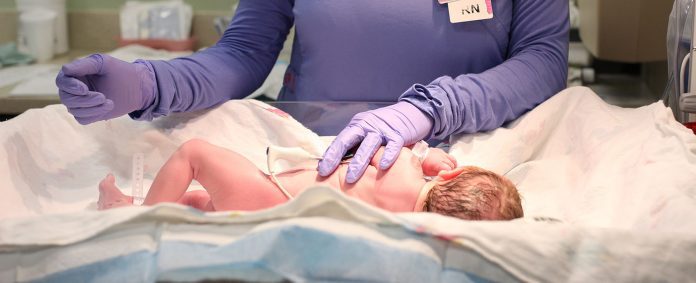
Pregnancy During COVID; How the Pandemic Has Changed Maternity Care
The COVID-19 pandemic has dramatically changed how life looks for everyone, from how we work and how we learn, to how we stay connected and celebrate life’s greatest moments. Parents had an even more challenging time as they were forced to change the way they worked and begin working from home or became unemployed while instantly becoming their children’s teachers as schools began to close and move to remote learning. And for those parents who were pregnant, how and where they received their maternity care also became an important priority.
Welcoming a new baby is ordinarily a time of celebration that is marked with prenatal visits and ultrasounds, shopping and preparing for baby, and celebrations with family and friends. As the COVID pandemic forced the world to stop in March 2020, women and families that were expecting quickly realized that their pregnancies and births were not going to look or feel the way they had expected. Pregnancy is normally a time of great anticipation and excitement for families. It can also be a time of fear and worry about the unknown. As the pandemic took hold of the world, growing families had even more reasons to be anxious as they worried about their health and the health of their growing babies. The care they received also began to change into something that was unrecognizable.
Prenatal Care
Maternity providers had to quickly change how and where they were delivering their care to families in order to maintain safety and still provide the care women needed. Traditional maternity care changed rapidly. Offices shifted in-person visits to telehealth visits in order to protect women and staff from spreading the virus. In-person procedures were scheduled further apart, leaving some women to wait longer than usual for available appointments. Women were no longer allowed to bring anyone with them to their visits, including milestones like hearing the heartbeat for the first time or ultrasound visits. And providers were required to wear PPE (personal protective equipment) that felt like the hazmat suits seen in movies like “Contagion”.
Erin Graham, CNM, a Certified Nurse Midwife that worked in a free-standing birth center in Atlanta, GA at the beginning of the pandemic described how they quickly had to change how they saw their clients. “Women were scheduled for a telehealth visit and then they would come to a drive-thru tummy check where the midwife would listen to the baby’s heartbeat and measure their bellies from the safety of the client’s car”. While this was a quick-thinking solution that allowed care to continue for pregnant women, the experience was not the same as it was before the pandemic and it left some women to consider home birth as an alternative to their planned hospital or birth center birth in order to receive the high touch personal experience they were hoping for.
Hospital Changes
At the same time, hospitals began changing protocols on who could come into the hospitals. Families were left feeling confused and uncertain about how their birth was going to look and feel. Many hospitals restricted visitation policies dramatically, women were required to labor in masks, and in rare instances, alone aside from their medical team. While most hospitals still allowed partners to be with women as they labored, additional support people such as family members or certified doulas were excluded. In many instances, if partners were allowed, they were not allowed to come and go freely, leaving families scrambling for childcare for their additional children. Women and their partners were left with more questions than answers and the situation was changing so rapidly it became difficult for providers to help families know what to expect.
Prenatal Education
In addition to concerns regarding their birth, many women who had planned to take prenatal classes such as birth preparation, breastfeeding, and infant care classes were told their classes were either canceled or moved to virtual meetings on platforms such as Zoom and WebEx. Birth workers scrambled to move their in-person classes into a format that would still provide women and families with the information they needed to prepare for their new addition. Robin Ross, a childbirth educator and owner of Blissful Births, LLC. in the Chicago suburbs recalls how she handled the pandemic. “Almost overnight, I had to shift my in-person Hypnobirthing classes to Zoom.”
Ross completed her existing classes but soon realized that her business was not going to go back to normal as quickly as she had hoped. Initially, she dropped her prices and offered an array of classes online. “Women were not signing up for my classes and I was not allowed to support women in many of the hospitals in the area. I worried my business was not going to survive.” Ross recalls. But as the pandemic raged on, she began to see enrollment from all over the country and even from other countries into her classes. “I think moving forward, we’ll see a more hybrid offering of classes,” Ross says, “and that will expand access for women that may not have been able to take these classes before.”
Alternatives to Traditional Birth
By April or May, life had still not gone back to normal and many pregnant women began considering alternative options for their birth including home birth. For many low-risk women, the more personalized care with a home birth midwife and safety of not going into the hospital became an appealing alternative. Brie Johnson from Clover, SC learned she was pregnant with her third child the week before the world shut down. She had had two previous hospital births with an obstetrician in her home state of California. For her third pregnancy, she had already decided to have a home birth with a midwife when the pandemic hit. Her midwife immediately saw an increase in women seeking her care as the months of quarantine stretched on and eventually had to begin turning women away. However, Brie and other moms planning a home birth were not spared from the worry of what it might mean to have to go to the hospital in an emergency during a pandemic.
Maternity Care in a Post-COVID World
The good news is, as more people feel safer due to increasing vaccination rates getting us closer to herd immunity and more becoming known about the virus, maternity care is beginning to feel a little more normal for most women. Hospital restrictions have loosened and support people such as certified doulas are again allowed to support women through labor and birth in person. It has also highlighted the need for more providers offering alternatives to traditional hospital births.
Many prenatal resources including childbirth education classes have figured out creative ways to prepare new moms virtually. And new businesses are taking this opportunity to broaden access to reliable care and services in a post-COVID age. While the last year has certainly had an enormous effect on growing families, not all of the changes have been bad and could open up more options for women and families in the future.







